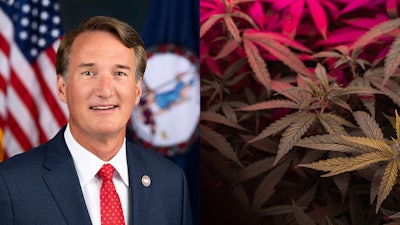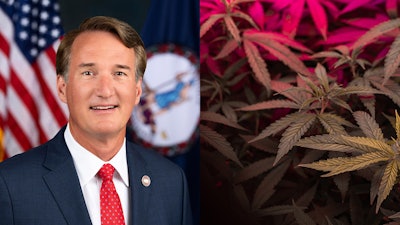

Virginia’s Decision on Recreational Cannabis: Controversy and Consequences
The recent veto by Virginia Governor Glenn Youngkin on proposed legislation to legalize recreational cannabis sales has sparked a heated debate in the state. With deep-seated concerns regarding health, safety, and economic implications, the governor’s decision has left many wondering what the future holds for Virginia’s cannabis market. In this opinion editorial, we take a closer look at the governor’s veto, assess the issues raised, and examine the tangled parts of the debate as both supporters and critics weigh in on its potential implications.
At the heart of the controversy lie two identical bills introduced by the Virginia legislature—SB 970 and HB 2485—which would have paved the way for regulated marijuana sales to adults aged 21 and over. Governor Youngkin’s decision to veto these bills was primarily based on concerns surrounding public health and safety, a stance that has prompted both political and community leaders to get into the fine points of cannabis regulation in the modern era.
Virginia Cannabis Retail Reform and Governor Youngkin’s Veto
Governor Youngkin’s veto of the retail marijuana legislation has been a lightning rod for debate among political leaders and community advocates alike. In his veto statement, the governor expressed a determination to keep Virginia’s approach to cannabis well-regulated by restricting sales to an unlicensed marketplace. According to him, existing experiences in other states have shown that expanding access to recreational cannabis without a sharp focus on safety can lead to a host of dangerous outcomes, ranging from negative health effects in children and adolescents to increased gang activity and violent crime.
The governor argued that the bill’s design was too intimidating, with several confusing bits in its regulatory framework that might ultimately result in the following issues:
- Increased risks to children’s and adolescents’ health
- Enhanced activity by criminal gangs and a surge in violent incidents
- Worsening of existing mental health challenges
- Decreased safety on the road due to impaired driving
- A significant imbalance between the costs of regulation and the tax revenue generated
By opting to veto the legislation, the governor aimed to prevent these negative outcomes and avoid a scenario where regulated cannabis would inadvertently boost the unregulated black-market environment. This decision not only sheds light on the challenging issues surrounding cannabis retail reform, but also uncovers the numerous twisted appeals and pitfalls of managing a state’s transition from prohibition to legalization.
Assessing the Health and Safety Concerns in Cannabis Retail
One of the key pillars of Governor Youngkin’s argument focused on health and safety challenges as a result of legalizing recreational cannabis. The governor’s statement was firm in that regulated sales may not provide the comprehensive safeguards needed for public health. Instead, he argued that similar initiatives in other regions have led to a significant increase in problems such as unsafe products and community safety risks.
Let’s take a closer look at the specific health and safety issues that were highlighted:
- Children’s and Adolescents’ Safety: The governor stressed that states moving along this path often see a harmful impact on young people, including exposure to cannabis at an early age and subsequent behavioral issues.
- Mental Health Challenges: There is concern over a direct correlation between cannabis use and the deterioration of mental health among the vulnerable segment of the population.
- Road Safety and Impaired Driving: A potential rise in impaired driving incidents poses a serious public safety threat, with experts noting a steep increase in accidents in states with similar policies.
- Law Enforcement Complications: Managing an expanded retail landscape could stretch law enforcement resources, with potential rises in violent crime linked to a larger supply chain.
While many of these problems are indeed concerning, critics argue that the current unregulated market might be just as, if not more, hazardous than a well-structured, licensed system. This debate underlines the need to poke around the fine details of both regulated and illicit markets to understand where real safety improvements can be made.
The Unregulated Cannabis Market in Virginia: Current Challenges
Since the legalization of cannabis possession in 2021, Virginia has seen the emergence of an unregulated cannabis market that operates outside the oversight of designated authorities. This untamed landscape has grown to an estimated value of nearly $3 billion annually, driven by consumer demand that remains unmet by legal retail channels.
Several points illustrate the challenges inherent in this uncontrolled environment:
- Lack of Product Safety: Without the regulatory oversight that comes with licensed dispensaries, consumers are at risk of purchasing contaminated or unsafe products.
- Economic Leakage: A significant portion of economic activity is funneled into the black market, depriving the state of potential tax revenue and economic benefits from a regulated system.
- Criminal Activity: The illicit market inadvertently fuels criminal activity, as unregulated sellers often operate outside the boundaries of conventional law enforcement.
- Consumer Risks: Without the protections offered by a sterilized, official sales channel, consumers may face misleading information about dosage, potency, and side effects.
This scenario brings forth a classic dilemma in public policy: whether maintaining the status quo in the face of lucrative illegal operations is a safer alternative than expanding into a complex, regulated framework that might initially appear as if it only shifts existing problems into a new structure.
Comparing State Approaches: How Other Regions Handle Cannabis Regulation
A useful way to figure a path through Virginia’s current predicament is to dive in and compare state-level experiences with cannabis legalization. Many other states have ventured down this road to varying degrees of success, leaving behind both cautionary tales and encouraging case studies. While the governor noted that legal states have witnessed increased risks related to health and safety, it is important to consider the following points:
- Regulatory Frameworks: Some states have adopted rigorous licensing procedures and mandatory safety protocols that have helped maintain control over the quality and distribution of cannabis products.
- Tax Revenues: Well-designed tax policies have allowed states to generate substantial public revenue, although critics maintain that these funds do not always offset the broader costs of public welfare and law enforcement.
- Public Health Outcomes: Comparisons reveal a complex picture, with some jurisdictions showing stability in public health metrics post-legalization while others report worsening trends in issues such as impaired driving and underage consumption.
In many cases, the contrast between states reveals that the fine shades of success depend on how well authorities manage the tricky parts of implementation. While states that have wrapped regulations tightly around dispensary operations boast lower incidences of product mishaps, those with more lenient rules sometimes struggle to find their way around pitfalls such as illicit secondary markets or oversupply.
Economic and Social Implications of Legalizing Recreational Cannabis
The debate surrounding cannabis legalization is not solely about public health and safety. There is a significant economic dimension that must be considered as well. Proponents of legalization argue that bringing cannabis sales under strict government control would generate a steady stream of tax revenues and promote job growth. On the flip side, concerns remain over whether these economic benefits outweigh the potential increase in social costs.
Below is a table summarizing some of the key economic and social benefits and drawbacks associated with legalizing recreational cannabis in Virginia:
| Aspect | Potential Benefits | Potential Drawbacks |
|---|---|---|
| Tax Revenue | Steady revenue stream, ability to fund public programs | Tax rates may not cover enforcement and public health costs |
| Job Creation | New opportunities in retail, cultivation, and distribution sectors | Job losses in traditional sectors and potential market disruptions |
| Consumer Safety | Product quality control and consumer protection regulations | Risk of continued unregulated market growth if demand exceeds supply |
| Social Impact | Reduction in criminal justice expenditures, potential for social justice reforms | Worries about increased use among youth and the normalization of drug use |
While the legislative framework was designed to address these issues by limiting sales to licensed dispensaries and instituting strict quality controls, critics argue that these measures may simply create a safer veneer over a fundamentally unaddressed problem. The argument centers on whether the economic benefits of legalization truly compensate for an increase in societal costs that may impact public health and road safety.
Prospective Policy Pathways: Balancing Regulation and Safety
For policy makers, one of the key challenges is to figure a path through the limited options available. The governor’s veto has polarized opinions on what the best way forward might be. Here, the focus shifts toward possible policy alternatives that might reconcile the dual objectives of expanding economic freedom and ensuring public safety.
Some of the options being discussed include:
- Revised Legislation: Amendments that further refine safety measures and oversight protocols could help address the governor’s concerns while opening the door to a regulated market.
- Phased Roll-Out: Gradually approved pilot programs in select regions could offer a controlled test of retail operations, allowing lawmakers to observe and adjust policies in real time.
- Enhanced Local Control: Granting local governments more power to regulate or even temporarily ban retail cannabis sales in their jurisdictions could provide tailored solutions that take into account community-specific needs and concerns.
Each of these alternatives comes with its own set of intimidating twists and turns, and any successful policy will need to work through these complicated pieces with care. Proponents of revised legislation argue that a more considerate, locally-driven regulatory framework could mitigate fears related to public health while gradually driving the illegal market underground.
Local Government Roles in Cannabis Regulation and Zoning
One important aspect that relieves some pressure from policymakers is empowering local governments to manage their own cannabis landscapes. Under the proposed legislation, local authorities would have been given the option to ban recreational cannabis sales within their jurisdictions through a community vote. This approach is seen by many as a sensible compromise, allowing for regional differences in public opinion and local priorities to be more effectively accommodated.
Here are some ways local governance could step in to make a difference:
- Zoning Regulations: Local authorities could designate specific areas for licensed cannabis retailers, thereby reducing the risk of inadvertent exposure in sensitive areas like schools and parks.
- Community Safety Measures: By enacting local rules and ordinances, municipalities can ensure that retail sales are structured to avoid concentration in neighborhoods that might be more vulnerable to criminal activity.
- Public Health Initiatives: Local governments could also mandate regular checks on retail outlets to ensure that safety protocols—such as proper product labeling and dosage warnings—are strictly followed.
The potential for local governments to weigh in provides a fantastic opportunity for communities to have a say in shaping policies that directly affect their everyday lives. In contrast to a top-down approach, this method advocates for a more nuanced understanding of the subtle details and little distinctions in each community’s needs and concerns.
Voices from the Field: Perspectives from Legislators and Advocacy Groups
The cannabis debate in Virginia has not gone unnoticed by key figures in the political and advocacy arenas. Democratic Delegate Paul Krizek, who was the lead sponsor of one of the bills, was sharply critical of the governor’s decision. In his statement, he underscored that by refusing to modernize Virginia’s cannabis regulations, the administration was allowing the surging illegal market to flourish unchecked. Krizek claimed that the veto would only further endanger community safety by providing an opening for illicit products and criminal activity.
On the other side of the argument, industry groups like the National Organization for the Reform of Marijuana Laws (NORML) have chimed in with their own admonitions. JM Pedini, NORML’s development director and executive director of its Virginia chapter, lamented that by keeping the cannabis market under the sway of unlicensed operators, the state has effectively compromised the ability to enforce product safety standards. Pedini argued that the proposed legislation was a common-sense measure designed to remove marijuana sales from unconventional outlets like corner stores and smoke shops, steering the market toward a regulated system that benefits only adults aged 21 and over.
While disruptions in opinion persist, it is clear that the debate is loaded with issues well worth digging into. Whether one prioritizes the economic, health, or community safety benefits associated with legalization, leaders and advocates alike now find themselves under the pressure of analyzing the fine points and little details that surround this contentious topic.
The Road Ahead: Finding Your Way Through Virginia’s Cannabis Future
As Virginia continues to grapple with the divergent opinions regarding cannabis legalization, it is clear that the future will require policymaking that takes into account the many subtle parts and confusing bits of the current debate. The governor’s veto leaves the state at a crossroads where the potential benefits of a regulated cannabis market must be carefully balanced against the risks of enhancing public safety issues and fueling an already booming unregulated market.
Key considerations for the road ahead include:
- Clarifying Regulatory Guidelines: Legislators and regulators need to work collaboratively to clarify and tighten the rules that would govern retail cannabis sales, ensuring that public safety is not compromised.
- Engaging Stakeholders: A comprehensive dialogue between policymakers, law enforcement, public health experts, and community groups is essential to make sure that all angles are covered.
- Iterative Policy Development: Given the nerve-racking potential for unintended consequences, any cannabis-related legislation should be implemented in phases, with room for adjustments based on observed results.
- Prioritizing Transparency: Clear public communication about both the benefits and drawbacks of legalization will help build trust and ensure that community members are well informed about the changes.
The governor’s stance is a reflection of the tension and challenges involved in changing longstanding policies in a manner that truly addresses the multi-faceted issues associated with an expanding regulated market. While many see his decision as a missed opportunity to modernize Virginia’s approach, others recognize the nerve-racking potential for harm if the system is overhauled without adequate safeguards. It is a true case of balancing economic promise against the equally real risks of public health and safety deterioration.
In a broader context, the path that Virginia takes in the coming years could potentially serve as a model for other states wrestling with similar debates. The need to find effective, responsible solutions is clear—one that takes into account the overlapping challenges of an entrenched illegal market, a desire for regulated access, and the inherent public safety issues that accompany both. By stepping back and taking a longer view, policymakers can attempt to steer through these complicated pieces by learning from the experiences of other states and addressing the subtle details that have been the downfall of prior attempts at legalization.
Conclusion
The governor’s veto of recreational cannabis sales legislation in Virginia throws a spotlight on the complex interplay between public safety concerns, market regulation, and economic opportunity. With strong opinions on both sides of the debate, it is as clear as ever that the decision-making process involves dealing with a multitude of delicate issues that cannot be easily separated. While supporters argue that the veto preserves essential safety measures and forestalls issues seen in other states, critics warn it only solidifies the grip of an already thriving unregulated market.
In the end, the challenge lies in figuring a path that reconciles these seemingly contradictory aims. Maintaining public health and safety while also providing a controlled, economic boost through regulated sales demands a balanced, thoughtful approach. Virginia must now work through these complicated pieces with an eye on crafting reforms that not only reflect the fine details of community demands but also learn from the lessons hidden within the experiences of other states.
As the discussion evolves, local governments, advocacy groups, and state legislators are all pressed to get around the twists and turns of this dilemma with a clear focus on achievable, safe outcomes. The future of cannabis legalization in Virginia is still very much in flux. However, the current debates and underlying criticisms could well serve as the ignition for future reforms that aim to reduce the risks associated with an unchecked market while promoting a framework that is fair, safe, and ultimately, beneficial to society at large.
Ultimately, whether one views the governor’s veto as a necessary precaution or as a roadblock to progress, the conversation is an essential one—demanding a close look at every subtle aspect of the policies we adopt and the ways in which we can protect the well-being of our communities while opening up new economic opportunities. Only through a careful, detailed examination and iterative policy development can Virginia hope to find its way toward a regulated and secure cannabis future.
Originally Post From https://www.forbes.com/sites/ajherrington/2025/03/25/virginia-governor-vetoes-recreational-cannabis-sales-bill/
Read more about this topic at
Virginia Governor Vetoes Recreational Cannabis Sales Bill
Retail marijuana sales legalization once again vetoed


